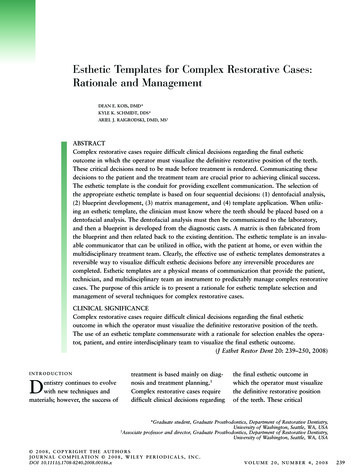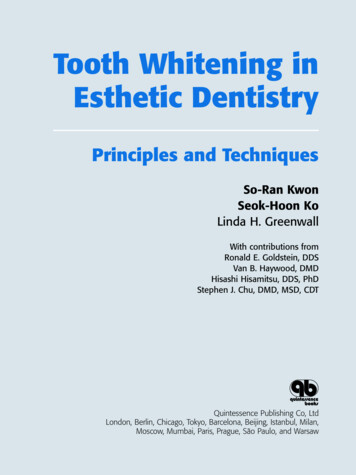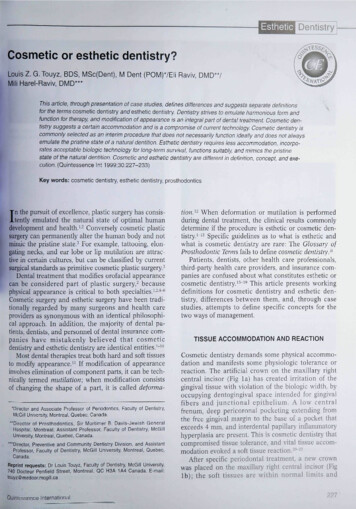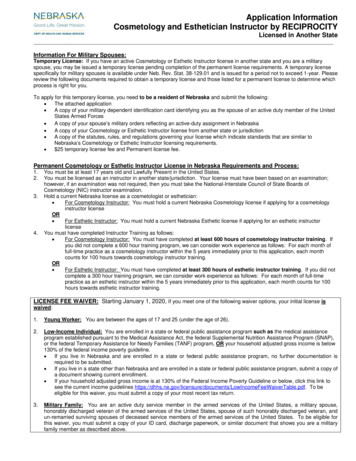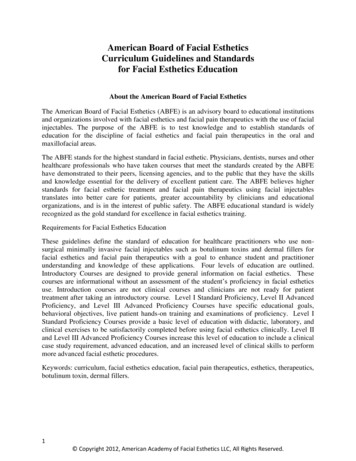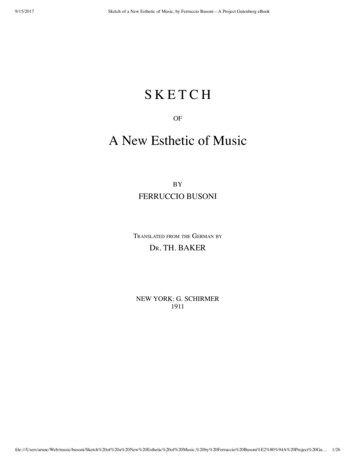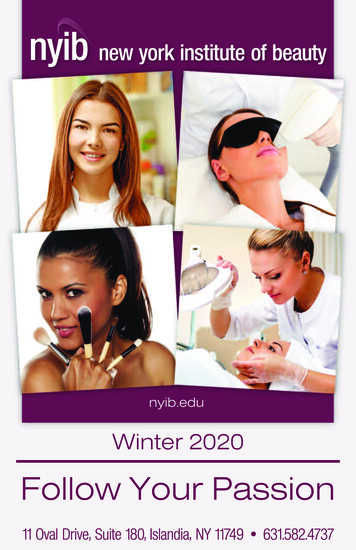
Transcription
EnglishDescriptionVariolink Esthetic is a colour-stable, adhesive luting system for the permanentcementation of ceramic and composite resin restorations. Variolink Estheticis offered in a purely light-curing (Variolink Esthetic LC) and a dual-curingversion (Variolink Esthetic DC).The special filler composition gives Variolink Esthetic a very high radiopacity.ShadesVariolink Esthetic is available in the following five shade gradations:ShadeEffectLight Translucency approx. 5%(opaque)LightTranslucency approx. 10%NeutralTranslucency approx. 17%WarmTranslucency approx. 12%Warm Translucency approx. 8.5%(opaque)Lighter /more whitishNoneDarker /more yellowishThe gradation of Variolink Esthetic shades is based on the effect that a lutingcomposite exerts on the brightness value of the final restoration. VariolinkEsthetic Neutral does not affect the brightness value. At the same time, itdemonstrates the highest translucency and is thus neutral in shade. Lightand Light make the restorations lighter, while Warm and Warm create adarker overall shade impression. In order to evaluate the overall effect of therestoration in conjunction with the various Variolink Esthetic shades prior topermanent cementation, we recommend using the Variolink Esthetic try-inpastes.CompositionThe monomer matrix of Variolink Esthetic is composed of urethanedimethacrylate and further methacrylate monomers. The inorganic fillersare ytterbium trifluoride and spheroid mixed oxide. Initiators, stabilizers andpigments are additional ingredients.The particle size is 0.04-0.2 μm. The mean particle size is 0.1 µm.The total volume of inorganic fillers is approx. 38%.Indication–Permanent adhesive luting of glass-ceramic, lithium disilicate glassceramic and composite restorations (inlays, onlays and veneers)–Only use Variolink Esthetic LC for restorations with a low thickness of 2mm that have sufficient translucency (e.g. restorations made ofIPS e.max HT).–The following overview provides recommendations for the selection ofthe suitable Variolink Esthetic LC shade:IndicationsShadeEffectVeneersLight Inlays / Onlaysconsiderably lightens --*Lightslightly lightens Neutralno shade effect Warmslightly darkens/more yellowish Warm considerably darkens/more yellowish --** The use of the shades Light and Warm may lead to visible restoration margins whencementing inlays/onlays.ContraindicationThe application of Variolink Esthetic is contraindicated–if a dry working field cannot be established or the stipulated workingprocedures cannot be applied;–if a patient is known to be allergic to any of the ingredients of VariolinkEsthetic.– Işıkla sertleşen rezin esaslı dentalyapıştırma materyali– Material de cimentação dental à basede resina fotoativadaPT Instruções de Uso– Φωτοπολυμεριζόμενη οδοντιατρικήρητινώδης κονίαTR Kullanma Talimatı– Material dental de cementadofotopolimerizable basado en resinaES Instrucciones de usoEL Oδηγίες Xρήσεως– Cemento composito dentalefotoindurenteIT Istruzioni d’uso– Tandheelkundig, lichtuithardendbevestigingsmateriaal op basis vankunsthars– Composite de collagephotopolymérisable à usage dentaireNL Gebruiksaanwijzing– Lysherdende, permanentsementeringskompositt– Lichthärtendes zahnärztlichesBefestigungscompositeDE GebrauchsinformationFR Mode d’emploi– ValokovetteinenyhdistelmämuovisementtiNO BruksanvisningFI KäyttöohjeetEN Instructions for Use– Light-curing resin-based dentalluting material Variolink Esthetic LCSide effectsSystemic side effects are not known to date. In individual cases, allergicreactions to individual components have been reported.
InteractionsPhenolic substances (e.g. eugenol, wintergreen oil) inhibit polymerization.Consequently, the application of products containing these components, e.g.mouth rinses and temporary cements, must be avoided.Disinfectants with an oxidative effect (e.g. hydrogen peroxide) may interactwith the initiator system, which in turn may impair the curing process.Therefore, do not disinfect the preparation and the syringe using oxidativeagents. Disinfection may be carried out, for instance, by wiping with medicalalcohol.Alkaline jet mediums applied on dentin (e.g. Airflow) may compromise theeffect of self-etching adhesives.Hemostatic substances may inhibit polymerization and/or lead todiscolouration. Therefore, the directions for use of these substances must beobserved.ApplicationFor more detailed information also refer to the Instructions for Use of theproducts used in conjunction with Variolink Esthetic.1Removal of temporary restoration and cleaning of the cavityRemove possible residue of the temporary luting composite from thecavity or the preparation with a polishing brush and an oil- and fluoridefree cleaning paste (e.g. Proxyt fluoride-free prophy paste). Rinse withwater spray.Subsequently, dry with oil- and moisture-free air. Avoid overdrying.Note:Cleaning with alcohol can lead to dehydration of dentin.2Try-in of the restoration and isolationSeat the restoration using the desired Variolink Esthetic try-in paste andcheck the shade, fit and occlusion of the restoration.Care should be taken when checking the occlusion of fragile and brittleceramic objects before they are permanently cemented, as there is a riskof fracture.If necessary, make adjustments with fine diamonds at medium speedand with slight pressure and adequate water cooling. Polish groundsurfaces.Adequate relative or absolute isolation using suitable auxiliaries, such asOptraGate or OptraDam Plus, is required.If the dental hard tissue is contaminated with saliva or blood duringtry-in, it needs to be cleaned again as described in section 1.3Pre-treatment of the restoration3.1 If a restoration which has been pre-treated in the dental laboratoryis contaminated with saliva or blood during try-in, the contaminatedbonding surface of the restoration needs to be cleaned as follows:– Following try-in, thoroughly rinse the restoration with water sprayand dry with oil-free air.– Shake Ivoclean before use and completely coat the bonding surface ofthe restoration with the product using a microbrush or brush.– Leave Ivoclean to react for 20 s, then thoroughly rinse with waterspray and dry with oil-free air.– Subsequently, prime the bonding surfaces with a bonding agent thatis appropriate for the respective restorative material (e.g. Monobond Plus). Make sure to observe the Instructions for Use of the bondingagent applied.3.2 Restorations that have not been pre-treated by the dental laboratoryshould be rinsed with water spray and dried after the try-in procedure.3.2.1 Subsequently, condition the bonding surfaces of the restoration asfollows:a) Glass-ceramic restorations (e.g. IPS Empress )– Etch with 5% hydrofluoric acid (e.g. IPS Ceramic etching gel) for60 s or according to the instructions of the manufacturer of therestorative material.– Thoroughly rinse with water spray and dry with oil-free air.b) Lithium disilicate glass-ceramic restorations (e.g. IPS e.max Press,IPS e.max CAD)– Etch with 5% hydrofluoric acid (e.g. IPS Ceramic etching gel) for20 s or according to the instructions of the manufacturer of therestorative material.– Thoroughly rinse with water spray and dry with oil-free air.3.2.2 Apply Monobond Plus with a brush or a microbrush to the pre-treatedsurfaces, let it react for 60 s and then disperse it with a strong stream of air.3.3 Alternatively, restorations made of glass-ceramics and lithium disilicateglass-ceramics (e.g. IPS Empress, IPS e.max Press, IPS e.max CAD) may beconditioned with Monobond Etch & Prime as follows, independent oftheir pre-treatment:– Following try-in, thoroughly rinse the restoration with water sprayand dry with oil- and moisture-free air.– Apply Monobond Etch & Prime on the bonding surface using amicrobrush and agitate it into the surface for 20 seconds. Allow toreact for another 40 seconds.– Thoroughly rinse off Monobond Etch & Prime with water spray untilthe green colour has disappeared. If any residue remains in themicroporosities, the restoration may be cleaned with water in anultrasonic unit for up to 5 minutes.– Dry the restoration with a strong stream of oil- and moisture-freecompressed air for approx. 10 seconds.3.4 Composite and fiber-reinforced composite restorations should alwaysbe conditioned according to the instructions of the manufacturer of therestorative materials. With Tetric CAD restorations, please observe theinstructions stated in the Tetric CAD Instructions for Use.4Pre-treatment of the preparation and application of the adhesive(e.g. Adhese Universal)Please observe the Instructions for Use of the adhesive used.4.1 Conditioning with phosphoric acid gel (optional)The bond to enamel can be improved by selectively etching the enamelor by applying the ”etch & rinse“ technique. Unprepared enamel surfacesmust be conditioned with phosphoric acid (e.g. Total Etch). Pleaseobserve the Instructions for Use for the phosphoric acid gel.a) Selective enamel etching Apply phosphoric acid gel (e.g. Total Etch) onto the enamel and allowit to react for 15-30 s. Then rinse thoroughly with a vigorous streamof water for at least 5 s and dry with compressed air until the etchedenamel surfaces appear chalky white.b) Etch & rinse technique Apply phosphoric acid gel (e.g. Total Etch) onto the prepared enamelfirst, and then to the dentin. The etchant should be left to react on
the enamel for 15-30 s and on the dentin for 10-15 s. Then rinsethoroughly with a vigorous stream of water for at least 5 s and drywith compressed air until the etched enamel surfaces appear chalkywhite.4.2 Application of Adhese Universal– Starting with the enamel, thoroughly coat the tooth surfaces to betreated with Adhese Universal.– The adhesive must be scrubbed into the tooth surface for at least 20 s.This time must not be shortened. Applying the adhesive on the toothsurface without scrubbing is inadequate.– Disperse Adhese Universal with oil- and moisture-free compressed airuntil a glossy, immobile film layer results.Important note: Avoid pooling as this may compromise the accuracyof fit of the definitive restoration.– Light-cure Adhese Universal for 10 s using a light intensity of 500 mW/cm² (e.g. Bluephase Style).5Seating of the restoration– Variolink Esthetic LC is sensitive to any blue light (operatory light,ambient light). Therefore, Variolink Esthetic LC should not bedispensed until right before use. Exposure to intensive light should beavoided during application.– Apply Variolink Esthetic LC with the application tip or a brush/spatuladirectly to the internal surface of the restoration.Note: Direct application of Variolink Esthetic LC to a preparation thathas been pre-treated with adhesive may - depending on the adhesiveused - lead to an acceleration of the curing process and affect theaccuracy of fit of the restoration.– Seat the restoration and fix/hold it in place during excess removal.– Remove all excess luting material.a) Wiping technique Remove excess material immediately with a micro-brush/brush/foam pellet/dental floss or scaler. Make sure to remove excessmaterial in time, especially in areas that are difficult to reach(proximal areas, gingival margins).b) Circular technique suitable for veneers / inlays / onlays – Lightcuring of excess and subsequent removalLight-cure excess material with a polymerization light (light intensity 500mW/cm²; e.g. Bluephase Style) for 2 s at a distance of10-15 mm by running the light probe along the entire cement line.In the case of laminate veneers, choose a start and end pointin the incisal area and light-cure the cement line by moving thepolymerization light in a circle in clockwise direction.In the case of inlays / onlays, choose a start and end point inthe mesial or distal region and light-cure the cement line byperforming a circular movement with the polymerization light.Thereafter, excess cement is easy to remove with a scaler. Makesure to remove excess material in time, especially in areas that aredifficult to reach (proximal or gingival margins).6Polymerization– As with all composite systems, Variolink Esthetic is subject to oxygeninhibition. This means that the surface layer (approx. 50 μm) does notpolymerize during curing, as it comes in contact with atmosphericoxygen. To prevent this, cover the restoration margins with glycerinegel/air block (e.g. Liquid Strip) immediately after excess removal.– Polymerize Variolink Esthetic in segments, starting with the proximalmargins:Light intensityExposure timeper mm ceramicand segment500 - 1,000 mW/cm²20 s 1,000 mW/cm²10 se.g. Bluephase Style– Rinse off glycerine gel/airblock (e.g. Liquid Strip).Manufacturer:Ivoclar Vivadent AGBendererstrasse 29494 Schaan/Liechtensteinwww.ivoclarvivadent.comDate information prepared:2018-06-25/Rev. 3666333/WE3Rx ONLYPL Instrukcja stosowania– Стоматологический фиксирующийкомпозитный цемент световогоотверждения– Lyshærdende permanent plastcementDA Brugsanvisning– Ljushärdande dentalt kompositcementSV Bruksanvisning– Cement światłoutwardzalnyFinishing of the completed restoration– Check occlusion and functional movements and make adjustments ifnecessary.– Finish the cement lines with finishing diamonds if necessary.– Smooth out the cement lines using finishing and polishing strips andpolish them with suitable polishing instruments (e.g. OptraPol ).– If necessary, finish the restoration with suitable polishers (ceramic: e.g.OptraFine ; composite resin: e.g. OptraPol ).RU Инструкция по применению7
Warning–Prevent any contact of uncured Variolink Esthetic with the skin / mucousmembrane and eyes.–Uncured Variolink Esthetic may have a slight irritating effect and causesensitization to methacrylates.–Customary medical gloves do not provide protection against thesensitizing effect of methacrylates.Shelf life and storage–Store Variolink Esthetic at 2-28 C/36-82 F.–Do not use Variolink Esthetic after the expiry date.–Do not disinfect syringes with oxidizing disinfectants.–Close Variolink Eshetic LC syringes immediately after use. Exposure tolight causes premature polymerization.–Expiry date: see note on syringes and packages.Keep out of the reach of children!For use in dentistry only.The material has been developed solely for use in dentistry. Processing should be carriedout strictly according to the Instructions for Use. Liability cannot be accepted for damagesresulting from failure to observe the Instructions or the stipulated area of application. The useris responsible for testing the material for its suitability and use for any purpose not explicitlystated in the Instructions. Descriptions and data constitute no warranty of attributes and arenot binding.DeutschBeschreibungVariolink Esthetic ist ein farbstabiles, adhäsives Befestigungs-System zurdefinitiven Eingliederung von Keramik- und Compositerestaurationen.Variolink Esthetic steht in einer rein lichthärtenden (Variolink Esthetic LC) undeiner dualhärtenden (Variolink Esthetic DC) Variante zur Verfügung.Die spezielle Füllerzusammensetzung verleiht Variolink Esthetic eine sehrhohe Röntgenopazität.FarbenVariolink Esthetic ist in den folgenden fünf Farbabstufungen erhältlich:FarbeEffektLight Transparenz ca. 5% (opak)LightTransparenz ca. 10%NeutralTransparenz ca. 17%WarmTransparenz ca. 12%Warm Transparenz ca. 8.5% (opak)Heller / weisslicherKeinDunkler / gelblicherDie Variolink Esthetic-Farbabstufung basiert auf dem Einfluss, den einBefestigungscomposite auf den Helligkeitswert der endgültigen Restaurationhat. Variolink Esthetic Neutral hat keinen Einfluss auf die Helligkeit,gleichzeitig die höchste Transparenz und ist dadurch farbneutral. Lightund Light , machen die Restauration heller, während Warm und Warm ,den Gesamtfarbeindruck dunkler machen. Es wird empfohlen die VariolinkEsthetic Try-In Pasten zu verwenden, um die Gesamtwirkung der Restaurationbei Verwendung der unterschiedlichen Variolink Esthetic-Farben vor derdefinitiven Befestigung zu verifizieren.ZusammensetzungDie Monomermatrix von Variolink Esthetic besteht aus Urethandimethacrylatund weiteren Methacrylatmonomeren. Die anorganischen Füllstoffe bestehenaus Ytterbiumtrifluorid und sphäroidem Mischoxid. Zusätzlich enthalten sindInitiatoren, Stabilisatoren und Pigmente.Die Partikelgrösse liegt zwischen 0.04–0.2 μm. Die mittlere Partikelgrössebeträgt 0.1 μm.Der Gesamtvolumenanteil anorganischer Füller beträgt ca. 38 %.Indikation–Definitive Befestigung von Glaskeramik-, Lithiumdisilikatglaskeramikund Compositerestaurationen (Inlays, Onlays und Veneers).–Variolink Esthetic LC nur bei Restaurationen mit geringer Materialstärke 2 mm und ausreichender Transparenz (z.B. IPS e.max HT) verwenden.–Folgende Übersicht gibt Empfehlungen für die Auswahl der geeignetenFarbe von Variolink Esthetic LC:IndikationenFarbeEffektVeneersLight Inlays / Onlaysstark aufhellen --*Lightleicht aufhellen NeutralKein Farbeffekt Warmleicht abdunkeln/gelblicher Warm stark abdunkeln/gelblicher --** Die Verwendung der Farben Light und Warm kann bei Inlay-/Onlay-Befestigungen zusichtbaren Restaurationsrändern führen.KontraindikationDie Verwendung von Variolink Esthetic ist kontraindiziert:–wenn eine sichere Trockenlegung oder die vorgeschriebeneAnwendungstechnik nicht möglich ist.–bei erwiesener Allergie gegen Bestandteile von Variolink Esthetic.NebenwirkungenSystemische Nebenwirkungen sind nicht bekannt. In einzelnen Fällen wurdenallergische Reaktionen auf Einzelkomponenten beschrieben.WechselwirkungenPhenolische Substanzen (z.B. Eugenol, Wintergrünöl) inhibieren diePolymerisation. Daher sollten Produkte, die diese Komponenten enthalten,z.B. Mundspüllösungen und provisorische Zemente, nicht verwendet werden.Oxidativ wirkende Desinfektionsmittel (z.B. Wasserstoffperoxid) können mitdem Initiatorsystem wechselwirken, wodurch die Aushärtung beeinträchtigtwird. Daher die Präparation und die Spritze nicht oxidativ desinfizieren. DieDesinfektion kann z.B. durch Abwischen mit medizinischem Alkohol erfolgen.Basische Strahlmittel auf Dentin (z.B. Airflow) können die Wirkung vonselbstätzenden Adhäsiven beeinträchtigen.
Blutstillende Mittel können die Polymerisation inhibieren und/oder zuVerfärbungen führen. Daher ist die Gebrauchsinformation dieser Mittel zubeachten.AnwendungFür detaillierte Hinweise beachten Sie bitte auch die separaten Gebrauchsinformationen der mit Variolink Esthetic verwendeten Produkte.1Entfernung des Provisoriums und Reinigung der KavitätKavität oder Präparation mit Polierbürste sowie öl- und fluoridfreierReinigungspaste z.B. Proxyt fluoridfrei) von eventuell vorhandenenResten des provisorischen Befestigungszementes reinigen und mitWasserspray spülen.Anschliessend mit wasser-/ölfreier Luft trocknen, Übertrocknungvermeiden.Hinweis: Eine Reinigung mit Alkohol kann zur Übertrocknung desDentins führen.2Einprobe der Restauration und TrockenlegungDie Restauration mit der gewünschten Variolink Esthetic Try-in Pasteeinsetzen, und die Farbwirkung, Passgenauigkeit und Okklusion derRestauration überprüfen.Die Okklusionsprüfung sollte bei zerbrechlichen bzw. sprödenkeramischen Werkstücken, bei denen die Gefahr einer Fraktur im nichtdefinitiv befestigtem Zustand besteht, nur sehr vorsichtig durchgeführtwerden.Falls erforderlich, Korrekturen mit feinem Diamanten bei mittlererDrehzahl, leichtem Druck und ausreichender Wasserkühlungdurchführen. Beschliffene Flächen nachpolieren.Eine adäquate relative oder absolute Trockenlegung mit Hilfsmitteln wiez.B. OptraGate oder OptraDam Plus ist erforderlich.Wird die Zahnhartsubstanz während der Einprobe mit Speichel oderBlut kontaminiert ist diese noch einmal, wie unter Punkt 1 aufgeführt, zureinigen.3Oberflächenvorbehandlung der Restauration3.1 Wird eine im Labor vorbehandelte Restauration während der Einprobemit Speichel oder Blut kontaminiert, so ist die kontaminierte Klebeflächeder Restauration wie folgt zu reinigen:– Die Restauration nach der Einprobe mit Wasserspray gründlichabspülen und mit ölfreier Luft trocknen.– Ivoclean vor Gebrauch schütteln und mit einem Microbrush oderPinsel auf die Klebefläche der Restauration deckend auftragen.– Ivoclean 20 Sekunden einwirken lassen, mit Wasserspray gründlichabspülen und mit ölfreier Luft trocknen.– Danach die Klebefläche mit einem, dem Restaurationsmaterialentsprechenden, Haftvermittler (z.B. Monobond Plus) primen. Dabeidie Gebrauchsinformation des verwendeten Haftvermittlers beachten.3.2 Wurde eine nicht bereits vom Labor vorbehandelte Restaurationeinprobiert, sollte diese nach der Einprobe mit Wasserspray gereinigtund anschliessend getrocknet werden.3.2.1 Danach wird die Klebefläche der Restauration wie folgt konditioniert:a) Restaurationen aus Glaskeramik (z.B. IPS Empress )– Ätzen mit 5%-iger Flusssäure (z.B. IPS Ceramic Ätzgel) für60 Sekunden oder gemäss Angaben des Herstellers derRestaurationsmaterialien.– Restauration mit Wasserspray gründlich abspülen und mit ölfreierLuft trocknen.b) Restaurationen aus Lithiumdisilikat-Glaskeramik (z.B. IPS e.max Press,IPS e.max CAD)– Ätzen mit 5%-iger Flusssäure (z.B. IPS Ceramic Ätzgel) für20 Sekunden oder gemäss Angaben des Herstellers derRestaurationsmaterialien.– Restauration mit Wasserspray gründlich abspülen und mit ölfreierLuft trocknen.3.2.2 Danach Monobond Plus mit einem Pinsel oder Microbrush auf dievorbehandelten Flächen auftragen, 60 Sekunden einwirken lassen,anschliessend mit starkem Luftstrom verblasen.3.3 Alternativ können Restaurationen aus Glaskeramik und LithiumdisilikatGlaskeramik (z.B. IPS Empress, IPS e.max Press, IPS e.max CAD) auch mitMonobond Etch & Prime wie folgt konditioniert werden:– Restauration nach der Einprobe mit Wasserspray gründlich abspülenund mit öl- und wasserfreier Luft trocknen.– Monobond Etch & Prime mit einem Microbrush auf die Klebeflächeauftragen und für 20 Sekunden einreiben. Anschliessend weitere40 Sekunden einwirken lassen.– Monobond Etch & Prime gründlich mit Wasser abspülen, bis diegrüne Farbe entfernt ist. Falls nach dem Abspülen Rückständein Mikroporositäten zurückbleiben, kann die Restauration imUltraschallbad für bis zu 5 min mit Wasser gereinigt werden.– Die Restauration mit einem starken Strom öl- und wasserfreier Luft füretwa 10 Sekunden trocknen.3.4 Restaurationen aus Composite bzw. faserverstärktem Composite sindgrundsätzlich nach Angaben des Herstellers der Restaurations materialien zu konditionieren. Bei Restaurationen aus Tetric CAD folgenSie bitte den Anweisungen der Gebrauchsinformation von Tetric CAD.4Vorbehandlung der Präparation und Applikation des Adhäsivs(z.B. Adhese Universal)Bitte folgen Sie den Anweisungen der Gebrauchsinformation desverwendeten Adhäsives.4.1 Konditionierung mit Phosphorsäuregel (optional)Durch selektive Schmelzätzung oder mittels „Etch & Rinse-Technik“ kannder Verbund zum Schmelz zusätzlich verbessert werden. UnpräparierteSchmelzareale müssen mit Phosphorsäure (z.B. Total Etch) konditioniertwerden. Beachten Sie die Gebrauchsinformation des PhosphorsäureÄtzgels.a) Selektive Schmelzätzung Phosphorsäuregel (z.B. Total Etch) auf Schmelz auftragen und für15–30 Sekunden einwirken lassen. Dann das Gel gründlich fürmindestens 5 Sekunden mit kräftigem Wasserstrahl abspülen undmit Druckluft trocknen bis die geätzten Schmelzareale kreidig weisserscheinen.b) Etch & Rinse-Technik Phosphorsäuregel (z.B. Total Etch) zuerst auf präparierten Schmelz,dann auf Dentin auftragen. Die Säure soll 15–30 Sekunden aufSchmelz und 10-15 Sekunden auf Dentin einwirken. Dann das Gelgründlich für mindestens 5 Sekunden mit kräftigem Wasserstrahlabspülen und mit Druckluft trocknen bis die geätzten Schmelzareale
kreidig weiss erscheinen.4.2 Applikation von Adhese Universal– Am Schmelz beginnend die zu behandelnde Zahnoberflächenvollständig mit Adhese Universal benetzen.– Das Adhäsiv für mindestens 20 Sekunden auf der zu behandelndenZahnoberfläche einreiben. Diese Zeit darf nicht verkürzt werden.Das blosse Verteilen des Adhäsivs auf der Zahnoberfläche ist nichtausreichend.– Adhese Universal mit öl- und wasserfreier Druckluft so langeverblasen, bis ein glänzender, unbeweglicher Film entstanden ist.Wichtiger Hinweis: Pfützenbildung vermeiden, da dies diePassgenauigkeit der Restauration beeinträchtigen kann.– Adhese Universal für 10 Sekunden bei einer Intensität von 500 mW/cm² lichthärten (z.B. Bluephase Style).5Eingliederung der Restauration– Variolink Esthetic LC ist empfindlich gegenüber jeglichem Lichtmit Blauanteil (OP-Leuchten, Umgebungslicht). Aus diesem Grundsollte Variolink Esthetic LC erst unmittelbar vor der Applikation ausder Spritze entnommen werden. Während der Applikation ist eineintensive Beleuchtung zu vermeiden.– Variolink Esthetic LC mit der Applikationskanüle oder Pinsel/Spateldirekt auf die Restaurationsinnenseite applizieren.Hinweis: Eine direkte Applikation von Variolink Esthetic LC auf diemit Adhäsiv vorbehandelte Präparation kann in Abhängigkeit vomverwendeten Adhäsiv zu einer Beschleunigung des Härtungsprozessesführen und die Passgenauigkeit der Restauration beeinflussen.– Die Restauration in situ bringen und während der gesamtenÜberschussentfernung fixieren.– Das überschüssige Befestigungscomposite entfernen.a) Wischtechnik Die Überschüsse unmittelbar danach mit einem Microbrush/Pinsel/Schaumstoffpellet/Zahnseide oder einem Scaler entfernen.Insbesondere auf die rechtzeitige Entfernung der Überschüsse inschlecht zugänglichen Bereichen (approximal, gingivale Ränder)achten.b) Kreistechnik für Veneers/Inlays/Onlays – Lichthärtung allerÜberschüsse und anschliessende Entfernung Die Zementüberschüsse werden mittels Polymerisationslampe(Lichtintensität 500mW/cm²; z.B. Bluephase Style) im Abstandvon 10–15 mm durch Abfahren der gesamten Zementfugeinnerhalb von 2 Sekunden lichtaktiviert. Bei Veneers den Start-/Endpunkt inzisal wählen und im Uhrzeigersinn kreisförmig die Zementfuge mit der Polymerisationslampebelichten.Bei Inlays/Onlays den Start-/Endpunkt mesial oder distal wählenund mit einer kreisförmigen Bewegung der Polymerisationslampeentlang der Zementfuge belichten.Die Entfernung mit einem Scaler ist dadurch leicht möglich.Insbesondere auf die rechtzeitige Entfernung der Überschüsse inschlecht zugänglichen Bereichen (approximal, gingivale Ränder)achten.6Polymerisation– Variolink Esthetic unterliegt wie alle Composites der Sauerstoffinhibierung; d.h. die oberste Schicht (ca. 50 μm), die während derPolymerisation in Kontakt mit dem Luftsauerstoff ist, härtet nicht aus.Um dies zu verhindern, die Restaurationsränder unmittelbar nach derÜberschussentfernung mit einem Glyceringel/Airblock (z.B. LiquidStrip) abdecken.– Variolink Esthetic nun segmentweise beginnend bei den approximalen Rändern polymerisieren:LichtintensitätBelichtungszeitpro mm Keramikund Segment500 - 1 000 mW/cm²20 s 1’000 mW/cm²10 sz.B. Bluephase Style– Glyceringel/Airblock (z.B. Liquid Strip) abspülen.7Ausarbeitung der fertigen Restauration– Okklusion und Funktionsbewegungen überprüfen undgegebenenfalls korrigieren.– Zementfugen ggf. mit Finierdiamanten nacharbeiten.– Zementfugen mit Finier- und Polierstreifen glätten und geeignetenPolierern (z.B.OptraPol ) polieren.– Die Restaurationsränder ggf. ebenfalls mit geeigneten Polierern(Keramik: z.B. OptraFine ; Composite: z.B. OptraPol ) nacharbeiten.Warnhinweise–Kontakt von unausgehärtetem Variolink Esthetic mit Haut/Schleimhautund Augen vermeiden.–Variolink Esthetic kann in unausgehärtetem Zustand leicht reizendwirken und zu einer Sensibilisierung auf Methacrylate führen.–Handelsübliche medizinische Handschuhe schützen nicht vorSensibilisierung auf Methacrylate.Lager- und Aufbewahrungshinweise–Variolink Esthetic bei 2–28 C lagern.–Variolink Esthetic nach Ablauf des Verfalldatums nicht mehr verwenden.–Keine Desinfektion der Spritzen mit oxidierenden Desinfektionsmitteln.–Variolink Esthetic LC Spritzen nach Gebrauch sofort verschliessen.Lichtzutritt führt zu vorzeitiger Polymerisation.–Ablaufdatum: siehe Hinweis auf der Spritze bzw. Verpackung.Für Kinder unzugänglich aufbewahren!Nur für zahnärztlichen Gebrauch!Das Produkt wurde für den Einsatz im Dentalbereich entwickelt und muss gemäss Gebrauchs information verarbeitet werden. Für Schäden, die sich aus anderweitiger Verwendung odernicht sachgemässer Verarbeitung ergeben, übernimmt der Hersteller keine Haftung. Darüberhinaus ist der Verwender verpflichtet, das Material eigenverantwortlich vor dessen Einsatz aufEignung und Verwendungsmöglichkeit für die vorgesehenen Zwecke zu prüfen, zumal wenndiese Zwecke nicht in der Gebrauchsinformation aufgeführt sind.
FrançaisDescriptionVariolink Esthetic est un système de collage, à teinte stable, destiné aucollage définitif des restaurations en céramique et en résine composite.Variolink Esthetic existe en version purement photopolymérisable (VariolinkEsthetic LC) et en version à prise duale (Variolink Esthetic DC).Les charges spéciales intégrées à la composition de Variolink Estheticapportent au matériau une radio-opacité très élevée.TeintesVariolink Esthetic est disponible dans les cinq degrés de teinte suivants :ShadeEffetLight Translucidité d'environ 5%(opaque)LightTranslucidité d'environ 10%NeutralTranslucidité d'environ 17%WarmTranslucidité d'environ 12%Warm Translucidité d'environ 8.5%(opaque)Plus clair /plus blancAucunPlus foncé /plus jauneLe dégradé des teintes de Variolink Esthetic se base sur l'effet produit parun composite de collage sur la luminosité de la restauration finale. VariolinkEsthetic Neutral n influe pas sur la luminosité : sa translucidité est la plusélevée, sa teinte est donc neutre. Light et Light rendent la restaurationplus claire, tandis que Warm et Warm créent une impression de teinteplus foncée. Pour apprécier l effet global de la restauration en fonctiondes différentes teintes Variolink Esthetic avant le collage définitif, nousrecommandons d utiliser les pâtes d essayage Variolink Esthetic try-in.CompositionLa matrice monomère de Variolink Esthetic se compose de diméthacrylate
Variolink Esthetic is a colour-stable, adhesive luting system for the permanent cementation of ceramic and composite resin restorations. Variolink Esthetic is offered in a purely light-curing (Variolink Esthetic LC) and a dual-curing version (Variolink Esthetic DC). The special filler composition gives Variolink Esthetic a very high radiopacity.

